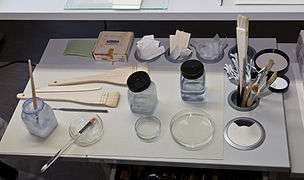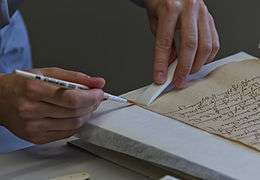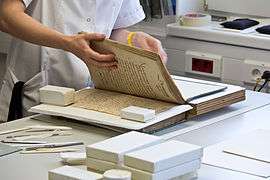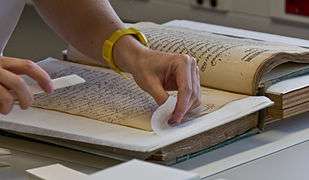Conservation and restoration of books, manuscripts, documents and ephemera
The conservation and restoration of books, manuscripts, documents and ephemera is an activity dedicated to the preservation and protection of items of historical and personal value made primarily from paper, parchment, and leather. When applied to cultural heritage, conservation activities are generally undertaken by a conservator. The primary goal of conservation is to preserve the lifespan of the object as well as maintaining its integrity by keeping all additions reversible. Conservation of books and paper involves techniques of bookbinding, restoration, paper chemistry, and other material technologies including preservation and archival techniques.
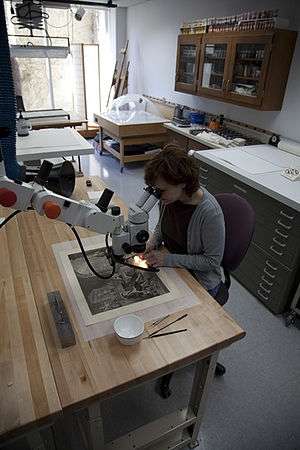
The history of early book conservation has yet to be written. Peter Waters is considered the father of modern book conservation. He developed new techniques of book and paper conservation after the 1966 Florence flood in Italy. The Book and Paper Group (BGP), the largest specialty group within the American Institute for Conservation (AIC), exchanges information and releases an annual journal on book and paper conservation. Book and paper conservation seeks to prevent and, in some cases, reverse damage due to handling, inherent vice, and the environment. Conservators determine proper methods of storage for books and documents including boxes and shelving to prevent further damage and promote long term storage. Carefully chosen methods and techniques of active conservation can both reverse damage and prevent further damage in batches or single-item treatments based on the value of the book or document.
Although there are no codified set of rules for book and paper conservation, an unwritten set of ethics govern modern conservation. Conservators seek to select treatments and alterations that are reversible and best maintain the aesthetic and historical integrity of the artifacts. Detailed and proper documentation of treatments applied is another important aspect of book and paper conservation.
Definition
Conservation of books and paper involves preserving and stabilizing the material as it is while retaining as much of the original materials as possible.[1] Conservation differs from restoration which involves returning a book or manuscript to new condition with the use of more invasive techniques and less preservation of original materials.[1] Preservation is an umbrella term which encompasses conservation and restoration; however, the terms are sometimes used incorrectly when referring to library and archive conservation.[2] The main goal of modern conservation is to maintain the integrity of the original parts of the object and that any additions due to restoration must be reversible.[3] There are two approaches of conservation: active or interventive conservation and passive or preventive conservation.[4] Active conservation involves evaluating the condition of an object and treating to prevent further decay by cleaning, repairing, and restoring when necessary. In preventative conservation, the science of storage and display are employed in order to control and stabilize the environmental conditions affecting the object in order to prolong its life span.[5] Conservation incorporates the fields of bookbinding, restoration, paper chemistry, and other material technologies including preservation and archival techniques.[6]
Because conservation is one example of effort to preserve materials, it can be considered a subcategory of preservation.[7] Conservation often accompanies preservation strategies such as proper storage and display, environmental monitoring, handling training, reformatting and security.[8] However, there are many nuances to conservation and conservators must make decisions about how they will treat the object based on how it will be used or displayed. For example, library conservation requires that the books be legible and usable, but not necessarily aesthetically pleasing. On the other hand, a book or document to be displayed in an exhibit may need to be presented in a more visually appealing condition.[9] Paper-based items, such as books, scrapbooks, manuscripts, letters, journals and diaries, certificates, maps, deeds, newspapers, drawings, miniatures, and postcards present distinctive concerns when it comes to care and conservation. Unlike works of art on paper, these items are often handled directly and repeatedly to access information.[10] Even paper ephemera like newspapers and letters may be significant historical records or family mementos.[11]
History
The history of early conservation has not yet been written, and early conservators recorded little of their work. Consequently, modern conservators are responsible for recording the previous conservation work they find when evaluating objects.[12] As early as 750 B.C., Old Testament prophets Isaiah and Jeremiah advised on the importance of the preservation of documents for future use.[13] In 1627, Gabriel Naudé published Advis pour dresser une bibliothèthe which contained a chapter discussing book preservation.[13] The first substantial work on the subject of book restoration was Alfred Bonnardot's Essai sur l'art de Restaurer les Estampes et les Livres, first published in Paris in 1846.[14][15][16] Until the late-nineteenth century, the preferred practice was to restore objects to newer or better condition with little regard to original style or composition. However, modern conservation seeks to treat books and paper as little as possible.[9]
Peter Waters, considered the father of modern book conservation, was the conservation coordinator at the National Central Library after the 1966 flood of the Arno in Florence, Italy, and was accompanied by hundreds of conservators from around the world.[17][18] Before the flood, library conservation was not yet an established field.[19] The water affected one-third of the library collections including periodicals, newspapers, fine prints, maps, posters, and the Magliabechi and Palatine rare-book collections.[20] The flood broke the tradition of maintaining proprietary trade secrets and conservation treatments as the disaster necessitated the collaboration of the world's most experienced book and paper conservators.[20] One book and paper conservation technique that resulted from this collaboration was the development of the "heat-set tissue" paper mending.[21] Another development from the Florence floods was the study of limp vellum binding and its usefulness in conservation due to its resistance to water damage.[22] Experienced in large scale archival disasters, Waters defined seven essential requirements for successful recovery after the flood.[17] The first publication of a standard of practice for conservators was published in August 1964 in Studies in Conservation by the International Institute for Conservation American Group, now the American Institute for Conservation (AIC). An updated version was released in 1994.[23]
Christopher Clarkson originally coined the term "book conservation" in Florence in 1967 in order to differentiate the early European conservation techniques which sought to preserve only the text of a book. Clarkson argued that "foreign marks" and "foreign matter" are important to understand the book's physical history and the social history in which the book resided and that this evidence of use should be preserved.[24] In 1968, the International Centre for the Study of the Preservation and Restoration of Cultural Property organized an international seminar on the subject of conservation of library materials in Rome.[25] In 1969, the first university-level conservation conference occurred at the University of Chicago where they published Deterioration and Preservation of Library Materials.[25] The Book and Paper Group (BGP) is the largest specialty group within the AIC. Through meetings and publications, the BPG exchanges information about the conservation of books and paper.[26] The BPG releases a journal The Book and Paper Group Annual, on the subject of book and paper conservation.[27]
Agents of deterioration
Poor handling is the primary cause of deterioration for books, manuscripts, and ephemera; however, a poor environment can also be a cause of deterioration for books and paper.[28] Conservators must have knowledge of agents that cause decay in order to preserve items.[5] Agents of deterioration can include mishandling, light, fluctuating humidity, dust and pollution, fire, water, gas and heat, neglect, and pests and other vermin.[29] Inherent vice is "the quality of a material or an object to self-destruct or to be unusually difficult to maintain".[30] Paper, books, manuscripts, and ephemera are prime examples of materials subject to inherent vice. Early paper was handmade from plant fibers such as flax, hemp, and cotton which are durable and can last for centuries.[31] In the mid-19th century, machine-made paper was introduced, and wood pulp became the most common, least expensive ingredient in paper, especially in newspapers. The presence of lignin in wood pulp paper causes acid to degrade the cellulose, which causes the paper to become brittle and discolored over time.[32] In addition, paper has the natural ability to absorb and retain moisture from the atmosphere, making it prone to the growth of mold, fungi, and bacteria.[33] Furthermore, some inks used in old books and manuscripts are harmful to paper. Iron gall ink, most commonly used from the 8th century through the end of the 19th century, contains acid and can corrode the paper in humid conditions.[34]
Insects and vermin are naturally attracted to paper because paper is made of cellulose, starch and protein, materials that provide sources of nourishment.[33] The most common pests are roaches, silverfish, and various types of beetles.[35] Book lice feed on mold spores found on paper and cardboard, and although they do not cause visible damage, their decomposition and excretions can stain paper and may also nourish other pests, continuing the cycle of damage.[31] Freezing collection items can mitigate pests.[35] However, some materials should not be frozen, such as books made with leather, because the cold temperatures may cause the fat to rise to the surface of the leather resulting in a white or yellow area called a bloom.[35] The use of insecticides directly on collection materials is not generally recommended. However, if the infestation is severe, and fumigation is the best option, the affected items should be separated from the rest of the collection for treatment.[33]
Extremes of temperature or relative humidity are damaging from either end of the spectrum (low or high).[36] High heat and low relative humidity can cause paper to become brittle and leather bindings to crack.[37] High temperatures and high relative humidity accelerate mold growth, foxing, staining, blooming, disintegration, and "red rot" in leather bindings. Fluctuations in temperatures and humidity may also cause cockling: a wrinkling or puckering preventing the surface from laying flat.[38] Air quality must also be taken into consideration. Dust tends to absorb moisture, providing a suitable environment to attract mold growth and insects.[39] Dust can also become acidic when combined with skin oils and the surface of paper.[33] All kinds of light (sunlight, artificial light, spotlights) can be harmful.[34] Light can result in fading, darkening, bleaching, and cellulose breakdown. Some inks and other pigments will fade if exposed to light, especially ultraviolet (UV) light present in normal daylight and from fluorescent bulbs.[39] Any exposure to light can cause damage, as the effects are cumulative and cannot be reversed.[37]
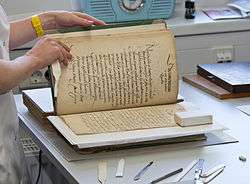
Storage methods and materials
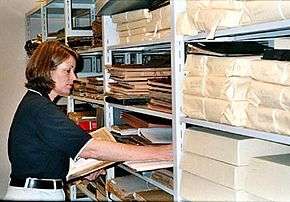
In the early 2000s, conservators determined that preservation of materials should no longer be governed by a universal standard but rather rely on a localized approach.[40] Storage in a cool, dry, clean, and stable location can extend the life of an item.[41] Manuscripts and paper documents are often stored in protective archival-quality boxes and folders, made of acid-free and lignin-free materials.[42] Documents with heavy use may be stored or encapsulated in a clear polyester (Mylar) film sleeve or folder. As added protection against acid formation, paper-based storage materials may have a buffer, such as calcium carbonate, which can neutralize acids as they form in the storage materials.[42] Boxes should not be overfilled. Items may be interleaved with acid/lignin-free paper.[39] If boxes are only partially full, spacers may be used, or the box may be stored horizontally.[31] Large format material is best stored in a plan cabinet with shallow drawers.[39] The rolling of large items (e.g. maps) should be avoided where possible; but if there is no other option, the item should be rolled around a large diameter archival quality tube.[43]
Until recently, baked enamel steel shelving was considered the best option for book storage; however, if not properly baked the enamel coating can give off formaldehyde and other volatile compounds that can harm collections. Unless properly baked, enamel-coated shelves are no longer a widely recommended shelving option. Professional testing can confirm that shelves are properly baked. Powder-coated steel shelving prevents off-gassing problems associated with baked enamel. Chrome-plated steel shelving and anodized aluminum shelving are considered other options for metal shelving, aluminum shelving is considered the optimal choice, particularly for highly sensitive artifacts; however, it is also the most expensive. Wood shelving is a more economical option but the wood must be sealed to prevent the emission of acids and volatiles. The most recommended coating is moisture-borne polyurethane. Paints such as two-part-epoxy, latex, and acrylic can also be used, but they vary in their effectiveness and ease of use.[44] Average-size books should be shelved vertically, side-by-side so they can support each other.[41] Shelves should not be overpacked and should stand away from exterior walls. Oversized or fragile books may be stored horizontally and completely flat, but stacking should be kept to a minimum.[34] Books may be placed in supportive and protective boxes, to prevent soiling and abrasion and to provide structural support. Book boxes may range from simple four-flap enclosures made of archival safe paper or cardboard to custom clamshell or drop-spine boxes covered in book cloth.[41]
Active conservation and repair techniques
The four stages of conservation include cleaning, stabilization, repair, and restoration. The main objective of cleaning is to achieve clarity of surface detail.[45] Books and documents may be subjected to different types of cleaning. Conservators may clean dust from paper and leather with a soft brush or cloths, a specialized vacuum cleaner, nonchemical vulcanized rubber sponges, or nonabrasive erasing materials such as vinyl erasers.[46][31] In order to remove mold and insects, conservators use scalpels, aspirators, or specialized vacuum cleaners. Deep freezing is used to kill the insects.[47] Because some adhesive materials are acidic and stain paper, conservators have developed techniques to remove adhesive. Repairs made with water-based adhesives such as animal glue are removed in a water bath, by local application of moisture, or with poultices or steam. Synthetic adhesives and pressure-sensitive (self-adhering) tapes are usually dissolved or softened with an organic solvent before removal.[47] Washing not only removes dirt and aids in stain reduction; it also washes out acidic compounds and other degradation products that have built up in the paper. Washing also relaxes brittle or distorted paper and aids in flattening. When washing alone does not combat acidity, conservators use an alkaline buffer applied by immersion or by spraying.[47] Flattening follows aqueous treatment; paper is placed between blotters or felts under moderate pressure.[47]
When cleaning and alkalization alone are not sufficient to stabilize the artifact, conservators may opt to mend and rebind the materials. Mending and filling techniques include narrow strips of torn Japanese tissue adhered with a reversible non-staining adhesive such as starch paste or methylcellulose. Paper can also be mended with heat-set tissue repair. Holes or paper losses are filled individually with Japanese paper, with paper pulp, or with a paper carefully chosen to match the original in weight, texture, and color.[48][47] Books with broken sewing, loose or detached boards or leaves require special care.[49] Several techniques are used in conservation binding. The original sewing in a volume is retained if this is possible but is sometimes reinforced using new linen thread and sewing supports.[50] If the original binding is too deteriorated, the book may be rebound with new archival safe materials.[51] Weak or brittle paper is reinforced by backing them with another sheet of paper. Japanese paper is sometimes used as a backing, adhered with a starch paste.[52]
When extensive conservation of the object is impossible or not cost-effective, reformatting techniques are employed to minimize treatments and excessive handling.[52] Reformatting options include photocopying, digitization, and microfilming. Many libraries and universities have book copiers where the book can be supported at an angle, avoiding the damage to its structure that can be caused by forcing it flat.[53][34] In spite of the digital revolution, preservation microfilming is still used. Microfilm can have a life expectancy of 500 or more years, and only needs light and magnification to read.[54]
Mass conservation preserves many books and documents with the same problems, which reduces the cost of treatment and individual handling. Given the great variety of material found in archival material that would require sorting and separate treatments, mass conservation is more often applied to library material than archival material. The only mass conservation treatment that can realistically be applied to archival material is preventive conservation by means of temperature and humidity-controlled environments.[55] However, if archival material is sorted by material type, batch treatment can be applied to low to moderate value items. Batch treatment may include humidification, deacidification, or mending. Single-item treatment is required for high-value or complex books or documents that require detailed, individual documentation.[56]
Ethics
According to Andrew Oddy, "modern scientific conservation is governed by an unwritten set of rules or ethics".[57] There have been many failed attempts to codify these "rules" because conservation requires individual application and is dependent on the goals of the museum and curator; consequently, these approaches cannot be generalized.[57] Paul N. Banks wrote "The Laws of Conservation", also known as The Ten Laws of Conservation; though never officially published, they have been widely shared by his students.[9] The American Institute of Conservation (AIC) published a code of ethics and guidelines for conservation professionals involved in caring for cultural artifacts.[23] Book and paper conservators strive to be sure that the treatments and alterations applied to the artifacts are reversible so they can be undone. Consequently, book conservators are trained in the physical and chemical properties of the materials with which they work. However, complete reversibility is often impossible, thus conservators must be conscientious of the long term effects of chemical and physical treatments.[58]
Furthermore, conservators must make decisions about which treatments best match the strength and material of the object. In some instances, conservators may decide that it is better to store the object and make a reproduction for use rather than treat it if no treatment options are available due to financial or technological limitations.[58] Moreover, if treatment is used, it must be used as sparingly as possible to maintain the aesthetic and historical integrity of the artifact.[59] Generally, conservation techniques aim to mend and stabilize the item so it can be stored and used long-term. Conservators must consider the ethics of how a book or document should be restored or replicated without losing its aesthetic and historical integrity.[60] Another ethical aspect of book conservation is the detailed documentation of treatments and alterations including procedures and materials used. Photographic documentation is usually more detailed for single-item treatments than for batch treatments.[61] A trained conservator can observe past treatments done on the book or document, but good documentation specifies the exact techniques and materials used.[62]
The cleaning and repair of paper documents and books are assigned to a professional conservator.[31][46] Many paper or book conservators are members of a professional body, such as the American Institute for Conservation (AIC) or the Guild of Bookworkers (both in the United States), the Archives and Records Association (in the United Kingdom and Ireland), or the Institute of Conservation (ICON) (in the United Kingdom).[63]
Gallery
See also
References
- "Preservation and Conservation: Caring for Collections". Emory Libraries & Information Technology. Retrieved 29 January 2020.
- Cloonan 2015, p. xvii.
- Oddy 1992, p. 13.
- Oddy 1992, p. 21; Ashley-Smith 2018, p. 7
- Oddy 1992, p. 21.
- Roberts, Matt T.; Etherington, Don (1982). Bookbinding and the Conservation of Books: A Dictionary of Descriptive Terminology. Washington, D.C.: Library of Congress. p. 64. ISBN 0844403660. Retrieved 12 February 2020.
- "Preservation-Frequently Asked Questions". Library of Congress. Retrieved 29 January 2020.
- Cloonan 2015, p. 323.
- Cloonan 2015, p. 324.
- Landrey 2000, p. 31.
- Library of Congress, "Preservation Measures for Newspapers", Accessed 13 April 2014, .
- Oddy 1992, p. 10; Cloonan 2015, p. xxiv
- Cloonan 2015, p. xxiv.
- Norman, Jeremy. "Alfred Bonnardot Issues the First Book on the Restoration of Rare Books and their Bindings (1846)". HistoryofInformation.com.
- Petrov, Ferdinand (2015). The art of painting and the art of restoration. Vancouver, British Columbia: Ferdinand Petrov.
- Cloonan 2015, p. xxv
- Miller, William; Pellen, Rita M., eds. (2006). Dealing with Natural Disasters in Libraries. New York: The Haworth Press. Retrieved 24 January 2020.
- Waters 2016, p. 5
- Waters 2016, p. 456.
- Waters 2016, p. 5.
- Waters 2016, pp. 5-6.
- Etherington, Don (2018). "After Florence: Developments in Conservation Treatment of Books". In Conway, Martha O'Hara; Conway, Paul (eds.). Flood in Florence, 1966: A Fifty-Year Retrospective. Ann Arbor, Michigan: Michigan Publishing Services. ISBN 9781607854562. Retrieved 9 March 2020.
- "Core Documents: American Institute for Conservation of Historic and Artistic Works" (PDF). American Institute of Conservation. American Institute of Conservation. Retrieved 24 February 2020.
- Clarkson 2015, p. 328.
- Cunha & Cunha 1983, p. 4.
- "Book and Paper Group". American Institute for Conservation. American Institute for Conservation. Retrieved 24 February 2020.
- "The Book and Paper Group Annual". The Book and Paper Group Annual. American Institute for Conservation. Retrieved 24 February 2020.
- Landrey 2000, p. 33
- William Blades (1880). The Enemies of Books. London: Trübner & Co. Retrieved 1 January 2019.
- National Postal Museum, "Inherent Vice," Smithsonian, Accessed on 13 April 2014, .
- "How to Care for Paper Documents and Newspaper Clippings". Canadian Conservation Institute. 4 January 2002. Archived from the original on 12 March 2014. Retrieved 13 April 2014.
- Dava Tobey, "Preserving History," Minnesota Historical Society, Accessed on 13 April 2014, .
- Shelley 1992, p. 30.
- "How to Care for Books". Canadian Conservation Institute. 4 January 2002. Archived from the original on 12 March 2014. Retrieved 13 April 2014.
- Mary C. Baughman, “Approaches to Insect Problems in Paper and Books,” Harry Ransom Center, Accessed 13 April 2014, .
- Shelley 1992, p. 29
- Shelley 1992, p. 29.
- Cameo, "Cockling", Museum of Fine Arts Boston, Accessed 22 April 2014, .
- State Library of Victoria, "Caring for Works on Paper", State Library of Victoria, Accessed 13 April 2014, .
- Dardes, Kathleen; Standiforth, Sarah. "Preventive Conservation: Sustainable Stewardship of Collections". The Getty Conservation Institute. Getty Conservation Research Foundation Museum. Retrieved 19 February 2020.
- "Storage Methods and Handling Practices". Northeast Document Conservation Center. Northeast Document Conservation Center. Retrieved 5 February 2020.
- Sherelyn Ogden, “Storage Enclosures for Books and Artifacts on Paper,” Northeast Document Conservation Center, Accessed 22 April 2014, .
- Landrey 2000, p. 42
- Ogden, Sherelyn. "Storage Furniture: A Brief Review of Current Options". Northeast Document Conservation Center. Northeast Document Conservation Center. Retrieved 9 March 2020.
- Oddy 2015, p. 351.
- AIC, "Caring for Your Treasures," American Institute for Conservation of Historic & Artistic Works, Accessed 26 April 2014, .
- NEDCC, "Conservation Treatment for Works of Art and Unbound Artifacts on Paper," Northeast Document Conservation Center, Accessed 26 April 2014,
- Schechter 1999, pp. 10-17
- Landrey 2000, p. 45.
- NEDCC, "Conservation Treatment for Bound Materials of Value," Northeast Document Conservation Center, Accessed 26 April 2014,
- "Guidelines for Library Binding". Northeast Document Conservation Center. Northeast Document Conservation Center. Retrieved 9 March 2020.
- "Conservation Treatment for Works of Art and Unbound Artifacts on Paper". NEDCC. Northeast Document Conservation Center. Retrieved 19 February 2020.
- Landrey 2000, p. 33
- Steve Dalton. "Microfilm and Microfiche". Northeast Document Conservation Center. Accessed 22 April 2014.
- Ritzenthaler 2015, p. 374.
- Ritzenthaler 2015, pp. 374-375.
- Oddy 1992, p. 12.
- Ritzenthaler 2015, p. 375.
- Ritzenthaler 2015, p. 376.
- Ritzenthaler 2015, pp. 376-377.
- Ritzenthaler 2015, p. 377.
- Pickwoad 2015, p. 368.
- "What is Conservation". Institute of Conservation. The Institute of Conservation. Retrieved 9 March 2020.
Sources
- Ashley-Smith, Jonathan (2018). "The ethics of doing nothing". Journal of the Institute of Conservation. 41 (1): 6–15. doi:10.1080/19455224.2017.1416650. Retrieved 24 February 2020.CS1 maint: ref=harv (link)
- Clarkson, Christopher (2015). "Mininum Intervention in Treatment of Books". In Cloonan, Michele Valerie (ed.). Preserving our Heritage. Chicago: American Library Association. ISBN 9781555709372.CS1 maint: ref=harv (link)
- Cloonan, Michele Valerie, ed. (2015). Preserving our Heritage. Chicago: American Library Association. ISBN 9781555709372.CS1 maint: ref=harv (link)
- Cunha, George Martin; Cunha, Dorothy Grant (1983). Library and archives conservation: 1980s and beyond. Metuchen, NJ: The Scarecrow Press. ISBN 0810815877.CS1 maint: ref=harv (link)
- Landrey, George J. (2000). The Winterthur Guide to Caring for Your Collection. Hanover and London: University Press of New England. ISBN 9780912724522.CS1 maint: ref=harv (link)
- Oddy, Andrew, ed. (1992). The Art of the Conservator. Washington, D.C.: Smithsonian Institution Press. ISBN 1560982292.CS1 maint: ref=harv (link)
- Oddy, Andrew (2015). "Does Reversibility Exist in Conservation?". In Cloonan, Michele Valerie (ed.). Preserving our Heritage. Chicago: American Library Association. ISBN 9781555709372.CS1 maint: ref=harv (link)
- Pickwoad, Nicholas (2015). "Distinguishing Between the Good and Bad Repair of Books". In Cloonan, Michele Valerie (ed.). Preserving our Heritage. Chicago: American Library Association. ISBN 9781555709372.CS1 maint: ref=harv (link)
- Ritzenthaler, Mary Lynn (2015). "Excerpts from "Conservation Treatment"". In Cloonan, Michele Valerie (ed.). Preserving our Heritage. Chicago: American Library Association. ISBN 9781555709372.CS1 maint: ref=harv (link)
- Schechter, Abraham A. (1999). Basic Book Repair Methods. Westport, CT: Libraries Unlimited. ISBN 1563087006. Retrieved 9 March 2020.CS1 maint: ref=harv (link)
- Shelley, Marjorie (1992). Bachmann, Konstanze (ed.). Conservation Concerns: A Guide for Collectors and Curators. Washington D.C.: Smithsonian Books. ISBN 9781560981749.CS1 maint: ref=harv (link)
- Waters, Shelia (2016). Waters Rising: Letters from Florence. Ann Arbor, Michigan: The Legacy Press. ISBN 9781940965000.CS1 maint: ref=harv (link)
External links
- The American Institute for Conservation of Historic & Artistic Works
- National Gallery of Art Works on Paper
- AIC's Paper Conservation Catalog
- The Metropolitan Museum of Art Paper Conservation
- Northeast Document Conservation Center Book Conservation
- The Canadian Conservation Institute
- The Book and Paper Group Annual
